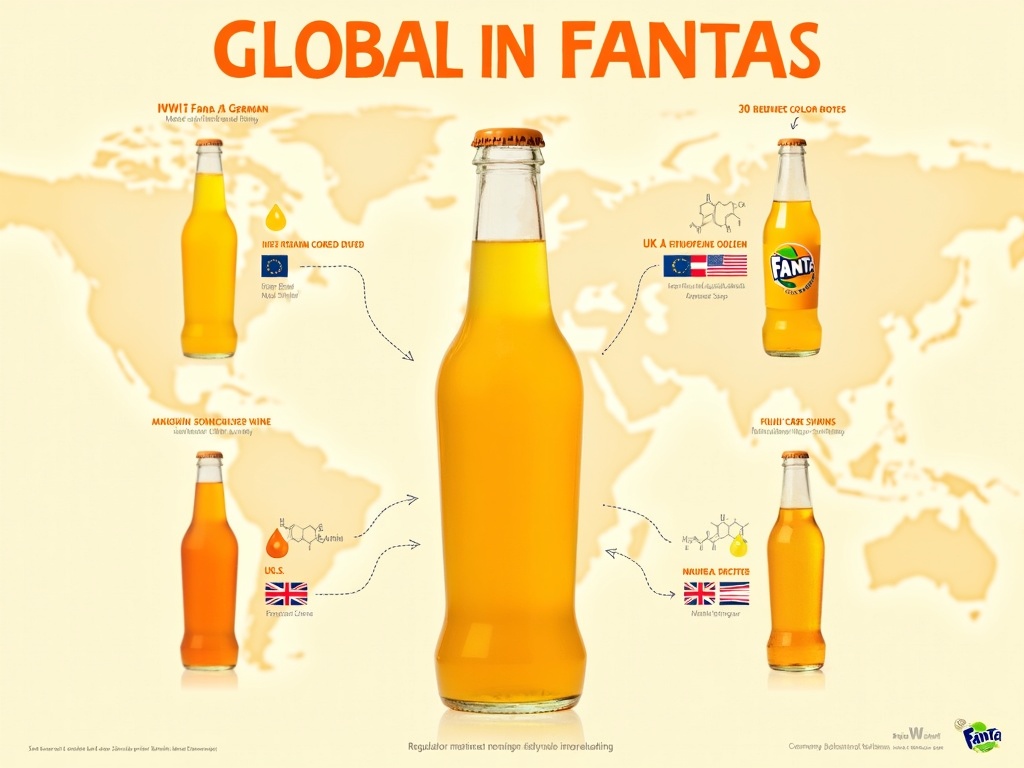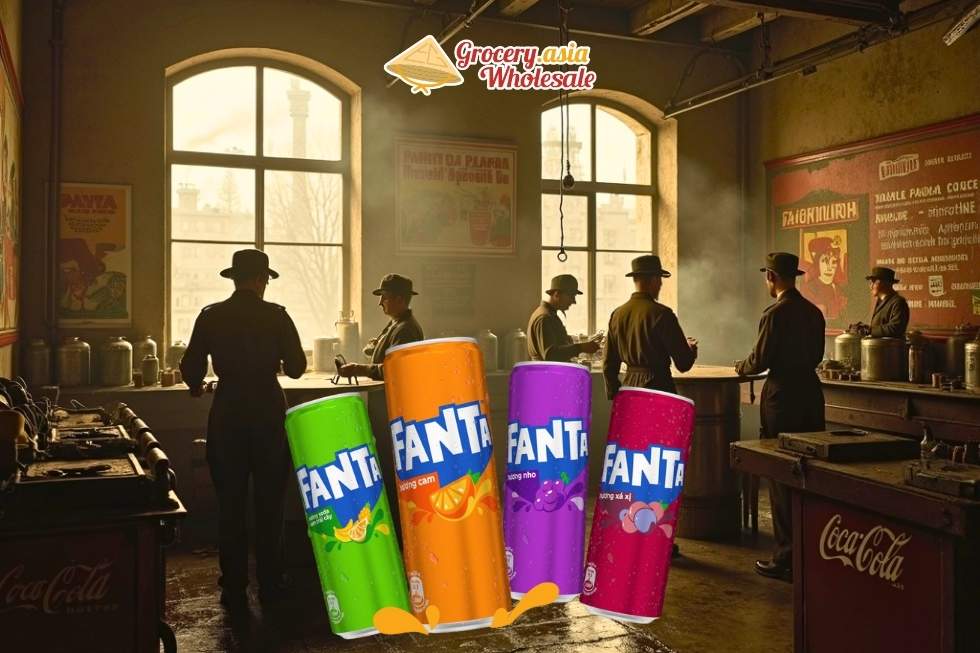No products in the cart.
Fanta Carbonated Soft Drinks, Soft Drinks
Who Made Fanta And Why It’s So Famous
Fanta was created by Max Keith, head of Coca-Cola Deutschland, in 1940 as a desperate wartime solution when Allied trade embargos cut off Coca-Cola syrup supplies during World War II. The brand achieved global fame through its 1955 Italian relaunch as an orange-flavored soda, transforming from a makeshift beverage made with whey and apple pomace into a billion-dollar empire spanning over 190 countries with more than 200 flavor varieties.
Table of Contents
Key Takeaways
- Wartime Origins: Fanta emerged in Nazi Germany in 1940 when Max Keith created a substitute beverage using local ingredients like whey, apple pomace, and saccharin to keep Coca-Cola’s German operations running during wartime embargos.
- Global Transformation: The modern Fanta began with its 1955 Italian relaunch as an orange-flavored soda, completely replacing the original German formula and establishing the citrus identity that defines the brand today.
- Massive Scale: Fanta operates as a billion-dollar business across more than 190 countries, offering over 200 different flavor varieties customized for local tastes and preferences.
- Regional Strategy: The brand’s success stems from hyper-localized flavors like Fanta Shokata in the Balkans, Fanta Guarana in Brazil, and Fanta Lychee in Asia, creating cultural connections while maintaining global recognition.
- Marketing Innovation: Fanta’s distinctive branding includes the twisted spiral bottle design, vibrant orange visual identity, and youth-focused campaigns like “Be More Fanta” that position it as the fun alternative to traditional colas.
Fanta’s Secret Nazi Germany Birth
I find it fascinating that one of today’s most beloved soft drinks has its origins in wartime Germany during one of history’s darkest periods. Fanta emerged in 1940 not as a planned global beverage launch, but as a desperate business solution during World War II.
The Wartime Innovation
Max Keith, head of Coca-Cola Deutschland, faced an impossible situation when the Allied trade embargo cut off his supply of Coca-Cola syrup from the United States. Rather than shutting down operations entirely, Keith made a bold decision to create an entirely new beverage using whatever ingredients he could source locally.
The original Fanta recipe bore little resemblance to today’s Fanta juice drink varieties. Keith’s team crafted this wartime substitute using whey (a cheese byproduct) and apple pomace (the fibrous leftovers from cider production). They sweetened this mixture with saccharin and beet sugar – ingredients that were available despite wartime shortages.
Keith chose the name ‘Fanta’ from the German word ‘Fantasie’, meaning ‘imagination’. This naming choice proved prophetic, as it required considerable imagination to transform these humble ingredients into a marketable beverage.
A Business Survival Strategy
Keith’s motivation wasn’t ideological support for the Nazi regime. Historical records show he wasn’t a Nazi Party member. His primary concern was maintaining employment for his workers and keeping the factory operational during uncertain times. The Coca-Cola Company in the United States had lost all control over their German operations due to the war, leaving Keith to make independent decisions.
This period represents a unique chapter in corporate history where local management operated completely autonomously from their parent company. Keith’s creation of Fanta demonstrated remarkable business adaptability under extreme circumstances.
The wartime Fanta became surprisingly popular among German consumers who had limited beverage options. Despite its unconventional ingredients, the drink provided a sweet escape during rationing and hardship. Keith’s factory continued producing this ersatz cola throughout the war years, maintaining both employment and morale in his community.
Once the war ended, production of the original German Fanta formula ceased immediately. The unique wartime recipe disappeared, making way for the fruit-flavored Fanta soda formulations that would eventually conquer global markets.
Keith’s wartime innovation inadvertently created a brand name that would outlive its humble origins. When Coca-Cola later developed new orange-flavored beverages in the 1950s, they revived the Fanta name, transforming it from a wartime necessity into a global phenomenon.
This hidden history reveals how some of today’s most recognizable brands emerged from unexpected circumstances. The modern Fanta jelly fizz soft drink and other contemporary variations share only a name with Keith’s original wartime creation, yet that connection links today’s consumers to one of the most remarkable survival stories in beverage history.
The transformation from whey and apple pomace to today’s vibrant fruit flavors illustrates how brands can completely reinvent themselves while maintaining their core identity. Keith’s imaginative solution during Germany’s darkest hour inadvertently launched what would become one of the world’s most successful soft drink franchises.
From Wartime Necessity to Global Orange Icon
The End of German Fanta and Coca-Cola’s Return
Fanta production in Germany ceased abruptly after World War II when Coca-Cola regained control of its German subsidiary. I find it fascinating how the company immediately discontinued the wartime formula that had sustained operations during the conflict. The Coca-Cola Company acquired the Fanta trademark during this transition, recognizing the potential value in a brand name that had already gained recognition in the German market.
The Italian Renaissance That Changed Everything
In 1955, Fanta experienced a complete transformation when it was relaunched in Naples, Italy. This time, the brand emerged as an orange-flavored soda crafted with local Italian citrus rather than the apple pomace and whey that characterized its German predecessor. The relaunch represented a strategic response to growing competition from PepsiCo and other companies that were aggressively expanding their flavored drink offerings.
The Italian formulation became the foundation for Fanta’s global expansion, not the original German version. I’ve observed how this decision proved pivotal in establishing Fanta soda as a vibrant, citrus-forward brand that could compete effectively in international markets. The choice of orange flavor aligned perfectly with Italy’s abundant citrus resources and created an instantly recognizable taste profile that consumers embraced.
Fanta evolved into Coca-Cola’s primary non-cola brand through this strategic repositioning. The company leveraged the existing trademark while completely reimagining the product’s identity and flavor profile. This approach allowed Coca-Cola to maintain brand continuity while distancing itself from any wartime associations that might have hindered international acceptance.
The 1955 Italian relaunch effectively marks the true beginning of the modern Fanta Orange known today. I consider this moment as the actual birth of the global Fanta phenomenon, as it established the orange citrus identity that would define the brand for decades. The success of this reformulation demonstrated how companies could transform existing trademarks into entirely new market opportunities.
Today’s diverse Fanta portfolio, including variations like Fanta juice drink and specialty products such as Fanta jelly fizz, traces its lineage directly back to that pivotal 1955 Italian launch. The brand’s evolution from wartime necessity to global orange icon illustrates how strategic product development can completely redefine a brand’s market position and consumer perception.
The Global Flavor Laboratory: 200+ Flavors Worldwide
I’ve discovered that Fanta operates as one of the beverage industry’s most ambitious flavor laboratories, with over 200 different varieties available across the globe. This extensive portfolio represents far more than simple product diversification – it’s a strategic approach that celebrates local tastes while maintaining global brand recognition.
The brand’s core lineup includes universally beloved flavors like Orange, Grape, Pineapple, Strawberry, and Lemon, which form the foundation of Fanta’s international presence. These classic varieties provide consistency across markets while serving as launching pads for regional experimentation.
Regional Specialties That Define Local Markets
The most fascinating aspect of Fanta’s strategy lies in its hyper-localized offerings that cater specifically to regional palates. Fanta Shokata brings together elderflower and lemon in Balkan countries, creating a sophisticated flavor profile that resonates with local botanical preferences. Dutch consumers enjoy Fanta Cassis, which captures the rich, tart essence of blackcurrant that’s particularly popular in Northern European markets.
Brazil showcases Fanta Guarana, incorporating the energizing South American superfruit that holds cultural significance throughout the region. Asian markets feature Fanta Lychee, which delivers the delicate, floral sweetness that appeals to regional taste preferences. Japan takes innovation further with Fanta Melon Frosty, while Taiwan offers the unique Fanta Lactic, demonstrating how far the brand pushes creative boundaries.
This hyper-local strategy creates an element of discovery that transforms Fanta into a travel experience. Tourists often seek out regional flavors as authentic cultural touchstones, while locals develop emotional connections to varieties that feel specifically created for their communities. The approach fosters genuine pride in products that reflect local identity rather than imposed global uniformity.
The contrast with Coca-Cola Classic’s standardized formula couldn’t be starker. While the flagship cola maintains identical taste worldwide, Fanta embraces variation as a core strength. This flexibility allows the brand to respond to emerging trends, seasonal preferences, and cultural shifts without compromising its global identity.
Regional flavor development requires deep market research and cultural understanding. Successful varieties often incorporate ingredients that hold historical significance or seasonal relevance in their target markets. Fanta’s innovation extends beyond traditional sodas into formats like jelly drinks and fizzy variations that further expand local appeal.
The financial impact of this strategy proves substantial. Markets with strong regional flavor offerings typically show:
- Higher engagement rates
- Increased consumer loyalty
- More word-of-mouth and social media buzz
Local flavors create conversation and excitement that traditional marketing often struggles to replicate.
Production logistics for 200+ flavors present significant challenges, but Fanta manages this through:
- Regional manufacturing partnerships
- Flexible production systems
- Cost-efficient distribution channels
This approach reduces shipping costs while ensuring freshness and quality control across diverse markets.
The success of regional flavors also influences global expansion decisions. Popular local varieties sometimes graduate to broader international availability, creating natural test markets for future launches. This organic growth pattern reduces risk while maximizing innovation potential.
Fanta’s flavor laboratory continues expanding, with new varieties appearing regularly across different markets. The brand’s willingness to experiment with unconventional combinations and local ingredients keeps it relevant in an increasingly competitive beverage landscape. This commitment to flavor diversity drives Fanta’s worldwide popularity by ensuring every market feels valued and understood.

A Billion-Dollar Beverage Empire
Fanta stands as one of The Coca-Cola Company’s most profitable ventures, consistently generating over $1 billion annually in revenue. This impressive financial performance positions it as a cornerstone within Coca-Cola’s extensive product portfolio, serving as the company’s second-oldest brand after the original Coca-Cola formula.
I find the global reach of this orange-flavored phenomenon truly remarkable. The brand operates across more than 190 countries, establishing an extraordinary international footprint that few beverages can match. This extensive distribution network demonstrates how Fanta juice drink variants have successfully adapted to diverse markets and consumer preferences worldwide.
Regional Market Leadership
Fanta’s commercial success varies dramatically across different continents, with the brand achieving market dominance in several key regions:
- Europe maintains strong brand loyalty, with countries like Germany showing particularly high consumption rates
- Africa represents a crucial growth market where Fanta often outsells competing soft drinks
- Asia continues expanding its market presence through localized flavor innovations
- South America, especially Brazil, ranks among the world’s highest Fanta consumers
Brazil deserves special recognition as one of the most significant markets for this carbonated beverage. The country’s consumers have embraced both traditional and innovative Fanta soda offerings, contributing substantially to the brand’s billion-dollar status.
However, I observe an interesting contrast in the United States market. While Fanta maintains a presence there, it operates more as a niche product compared to its dominant position elsewhere. American consumers tend to favor other soft drink options, making the U.S. market quite different from Fanta’s strongholds in other regions.
The brand’s ability to achieve and maintain its billion-dollar revenue status reflects sophisticated marketing strategies and product diversification. From traditional orange flavors to unique regional variants like Fanta jelly fizz options, the company continues expanding its product range to capture different consumer segments.
This financial success also demonstrates how The Coca-Cola Company has successfully leveraged Fanta’s historical roots into modern commercial triumph. The brand’s journey from wartime necessity to global powerhouse illustrates the potential for strategic brand development across international markets.
The Colorful Marketing Machine
I’ve watched Fanta transform from a simple orange soda into a global marketing powerhouse through decades of clever branding strategies. The brand’s success stems from its unwavering commitment to positioning itself as the fun, youthful alternative in the crowded soft drink market.
Iconic Campaigns That Defined a Generation
Fanta’s marketing genius truly shone during the early 2000s with the introduction of the ‘Fantanas’ campaign from 2002 to 2006. These energetic spokesmodels brought the catchy ‘Wanta Fanta?’ slogan to life, creating a cultural phenomenon that resonated with young consumers across America. The campaign’s success lay in its ability to make the brand feel accessible and entertaining rather than corporate.
Building on this foundation, Fanta launched the ‘Be More Fanta’ campaign, which continues to target younger demographics today. Fanta’s marketing campaigns consistently emphasize spontaneity, friendship, and living life to the fullest. These messages appear in vibrant commercials featuring bright orange colors, energetic animations, and playful scenarios that make viewers associate the brand with good times.
Visual Identity That Pops Off the Shelf
Fanta’s visual branding strategy goes far beyond traditional advertising. In 2017, the company introduced a distinctive twisted ‘spiral’ bottle design that became an instant recognition element. This innovative packaging doesn’t just look different – it feels different in consumers’ hands, creating a tactile brand experience that competitors struggle to match.
The brand’s visual elements work together like a carefully orchestrated symphony. I notice how Fanta uses vibrant orange colors as its primary identifier, complemented by splash graphics that suggest refreshment and energy. The dynamic logo design captures movement and excitement, while the unique bottle shape reinforces brand recognition even from a distance.
These marketing strategies accomplish something remarkable – they reinforce Fanta’s diverse flavor identity while positioning the brand as an exciting alternative to traditional colas. The company doesn’t just sell fruit-flavored beverages; it sells an experience of fun and spontaneity.
Fanta’s marketing machine succeeds because it understands its audience intimately. Rather than competing directly with cola giants on taste alone, the brand carved out its own space by emphasizing variety, fun, and youthful energy. This approach has allowed Fanta products to maintain relevance across multiple generations while continuously attracting new young consumers who see the brand as an authentic expression of their lifestyle.
The Chemical Conundrum: Ingredient Controversies
I’ve observed significant ingredient variations across Fanta’s global markets, often sparking heated debates about health and safety standards. The differences reveal how regulatory environments and consumer demands shape what goes into your favorite orange soda.
Artificial Additives Under Scrutiny
The Center for Science in the Public Interest targeted Fanta in 2011, specifically challenging the use of Yellow No. 6 artificial coloring in the U.S. formula. Critics raised concerns about potential health risks associated with synthetic dyes, particularly their possible links to hyperactivity in children. European markets tell a different story entirely — they’ve embraced natural alternatives like beta-carotene due to stricter food regulations that prioritize consumer safety over cost efficiency.
I find it fascinating that the original German Fanta actually contained no artificial ingredients whatsoever. World War II shortages forced creators to use apple fiber and whey as primary components, making it arguably more “natural” than today’s versions. This historical irony highlights how modern manufacturing has moved away from necessity-driven simplicity.
Sugar content presents another major point of contention across markets. Fanta UK made headlines in 2017 by slashing sugar content by 30% ahead of the country’s sugar tax implementation. This proactive approach demonstrates how policy changes drive reformulation decisions, even for established global brands.
The sweetener divide creates perhaps the most noticeable difference for consumers. U.S. Fanta relies heavily on high-fructose corn syrup, while many other countries stick with traditional cane sugar. I can personally attest that this substitution creates distinctly different flavor profiles — cane sugar versions often taste cleaner and less cloying than their corn syrup counterparts.
Regional adaptations extend beyond core ingredients to include specialized product lines that cater to local preferences. Some markets offer both regular and reduced-sugar varieties simultaneously, allowing consumers to choose based on their health priorities rather than being locked into a single formula.
These ingredient controversies reflect broader tensions between cost efficiency, regulatory compliance, and consumer health consciousness. While the “More Fanta, Less Serious” campaign promotes a carefree attitude, the reality behind ingredient selection involves serious considerations about public health, manufacturing costs, and regulatory requirements.
The ongoing evolution of Fanta’s formulations shows how even iconic brands must continuously adapt to changing standards. Whether it’s removing artificial colors, reducing sugar content, or exploring innovative textures and formats, these ingredient decisions ultimately shape how different generations and cultures experience the same brand.

Final Thoughts
Fanta’s story is more than just the history of a soft drink — it’s a powerful example of how brands can adapt, reinvent, and thrive across generations. From its wartime origins in Germany to becoming a billion-dollar global icon, Fanta proves that resilience and creativity can transform even the most unlikely beginnings into worldwide success. Today, with over 200 flavors across 190 countries, Fanta continues to shape beverage culture through innovation, local connection, and bold marketing.
👉 Looking to source Fanta, Coca-Cola, or other FMCG beverages directly from Vietnam?
Contact Asia Grocery Wholesale today for tailored quotes, reliable shipping options, and professional support to grow your business.
About us
Asia Grocery Co., Ltd is a trusted distributor, wholesaler, and exporter of fast-moving consumer goods (FMCG) from Vietnam, backed by over 20 years of expertise. We deliver authentic products from globally recognized brands such as P&G, Unilever, Redbull, Coca-Cola, Pepsi, Asiadeli, along with traditional and culturally significant Asian products, catering to customers worldwide with a special focus on Vietnamese and Asian communities abroad.
Sources:
- Snopes, “The Reich Stuff?”
- The Coca-Cola Company, “The Story of Fanta”
- Atlas Obscura, “The Surprising WWII Origins of Fanta”
- Business Insider, “The story of how Fanta was invented in Nazi Germany”


